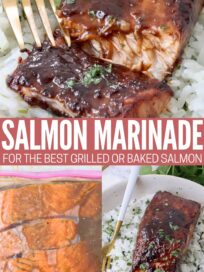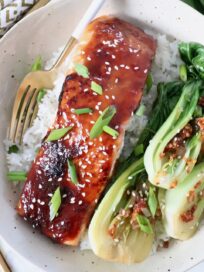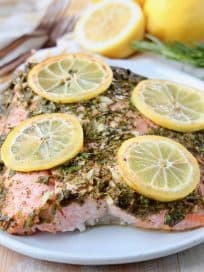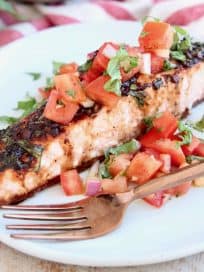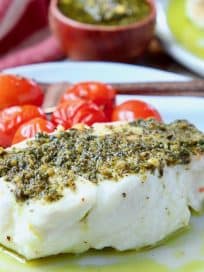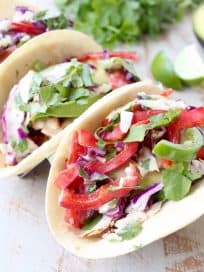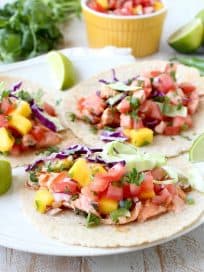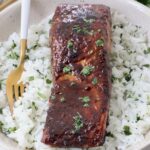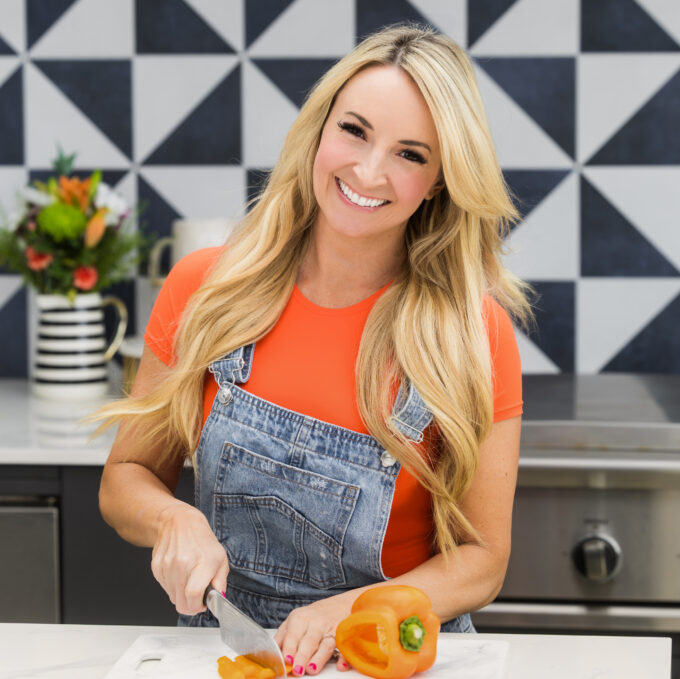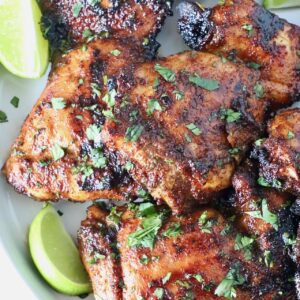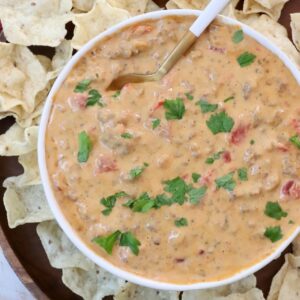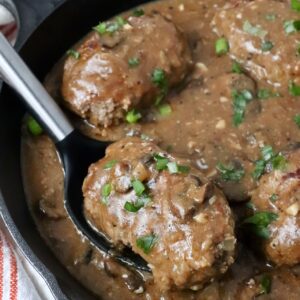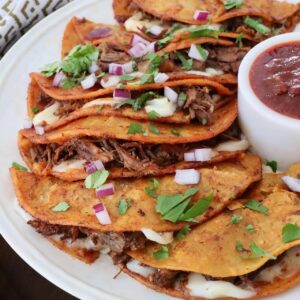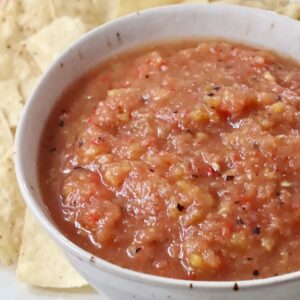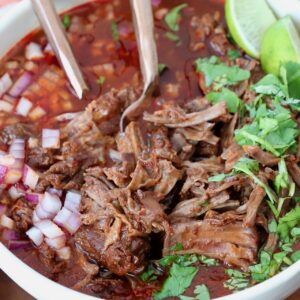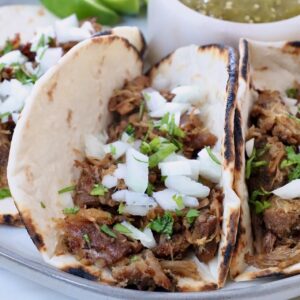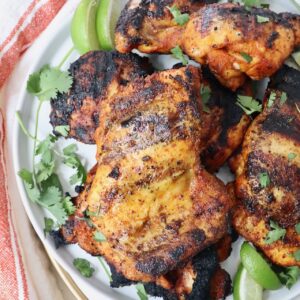Salmon Marinade
This post may contain affiliate links.
Create the best salmon with this tested and perfected Salmon Marinade recipe! Using 6 simple ingredients and a quick marinade, say goodbye to flavorless salmon and hello to the taste of sweet, salty, tangy goodness! After the salmon is marinated, quickly cook it on the grill, or in the oven for an easy meal.
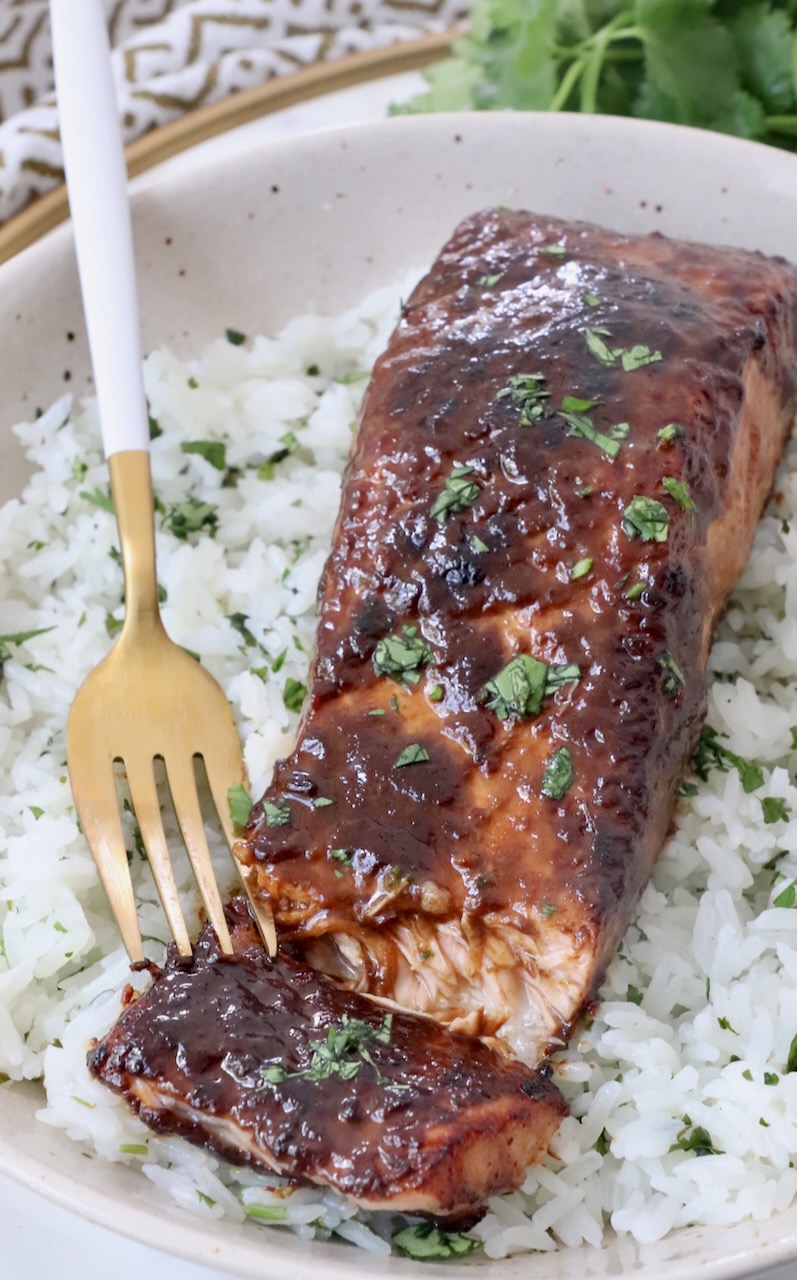
Table of contents
We eat a lot of salmon around our house, so I’m always looking for new ways to season and cook salmon.
For this recipe, I took notes from my favorite balsamic salmon recipe, and turned the glaze into a marinade. After a few trials, I found that I just wasn’t getting enough flavor from the salmon in the marinade, so after marinating the salmon, I turned the marinade into a glaze. This was when the magic happened!
It’s like doubling up on the flavor when you marinate the salmon, then glaze it with the marinade before cooking it. This is now the only way I’ll make marinated salmon! The flavor is incredible, and it’s delicious whether it’s cooked in the oven, or on the grill.
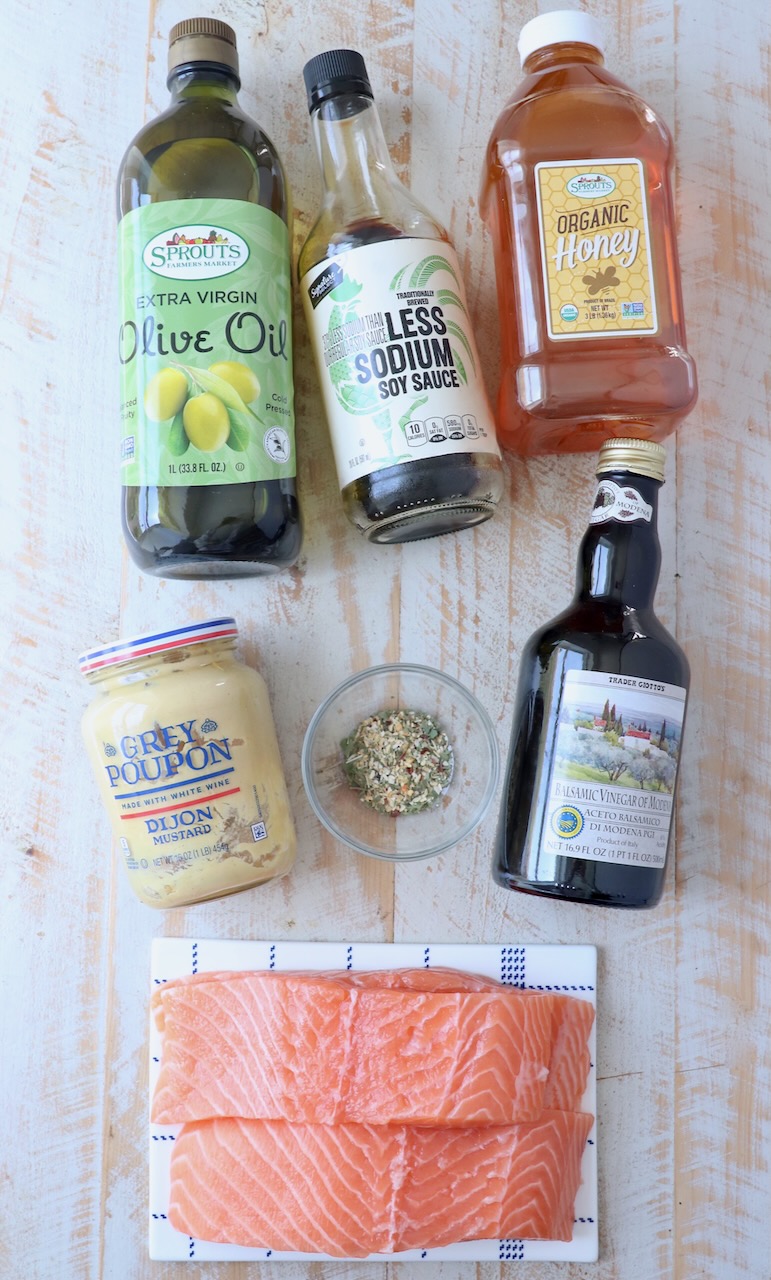
Ingredients
- Salmon – I recommend using four salmon fillets for this recipe that are between 6-8 ounces each. Try to find filets that are similar in thickness so that each piece of salmon cooks evenly.
- Olive oil – other vegetable oils can also be used, like avocado oil, sunflower oil, or canola oil. The oil helps moisten the salmon and keep it juicy, while also adding fat and flavor to the marinade.
- Balsamic vinegar – the vinegar adds acidity and a sweet tang to the marinade that pairs perfectly with the flavor of the salmon.
- Honey – is added to sweeten the marinade and give the salmon a wonderful caramelization as it cooks. You could also use maple syrup to replace the honey.
- Soy sauce – for this recipe, I recommend a low sodium soy sauce for just the right amount of saltiness.
- Dijon mustard – this is the secret ingredient that adds flavor to the marinade and helps the other marinade ingredients stick to the salmon for maximum flavor absorption!
- Italian seasoning – I like to use my homemade seasoning mixes whenever possible. Just click the link to the left. It’s easy to whip up with dried herbs and minced garlic in less than 5 minutes! You can also use store-bought premixed Italian seasoning.
Instructions
I’ve included step by step photos below to make this recipe super easy to follow at home. For the full detailed recipe instructions and ingredient quantities, scroll to the recipe card at the bottom of this post.
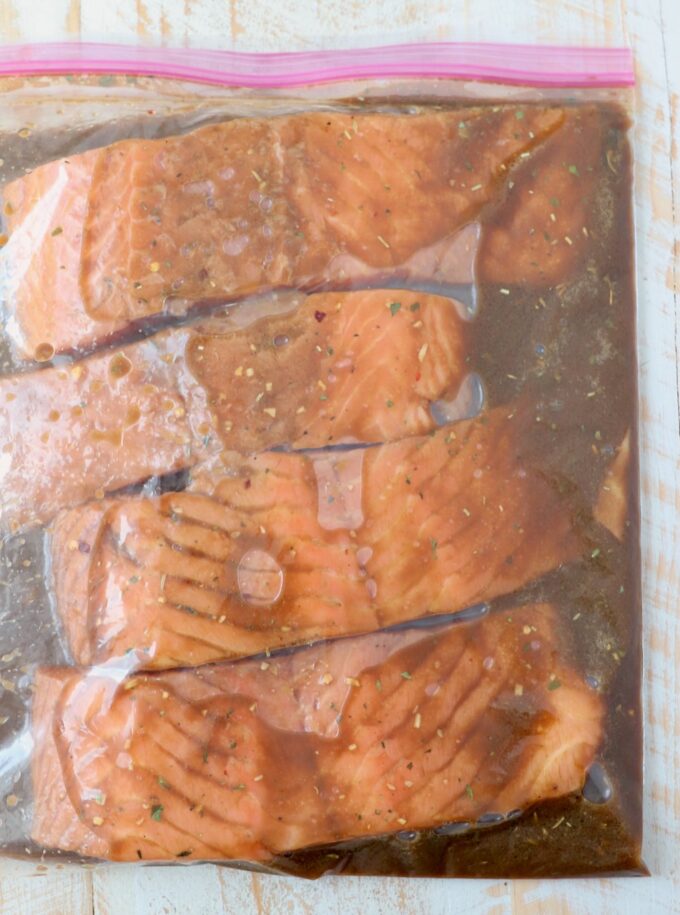
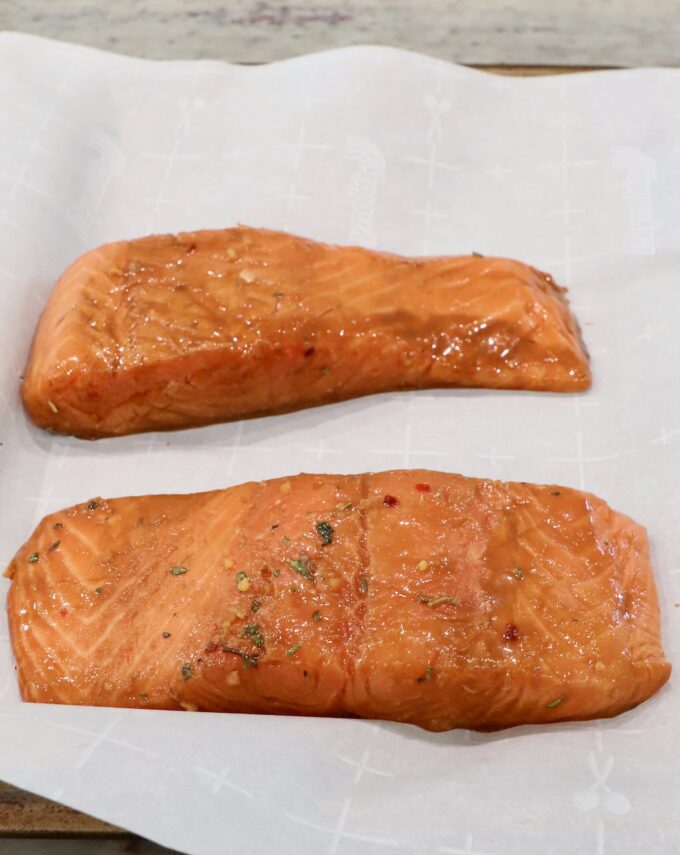
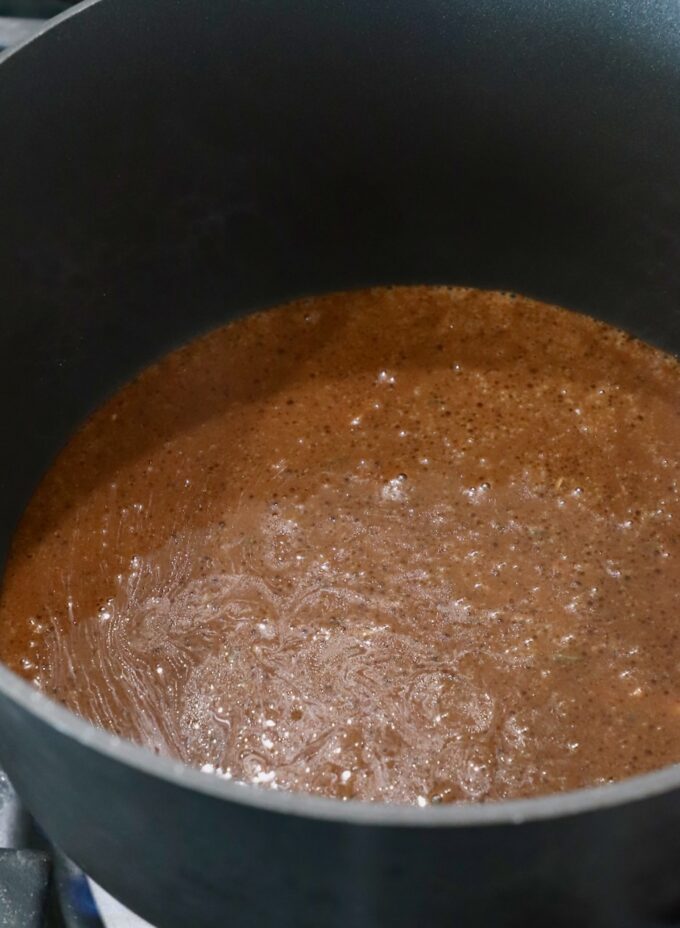
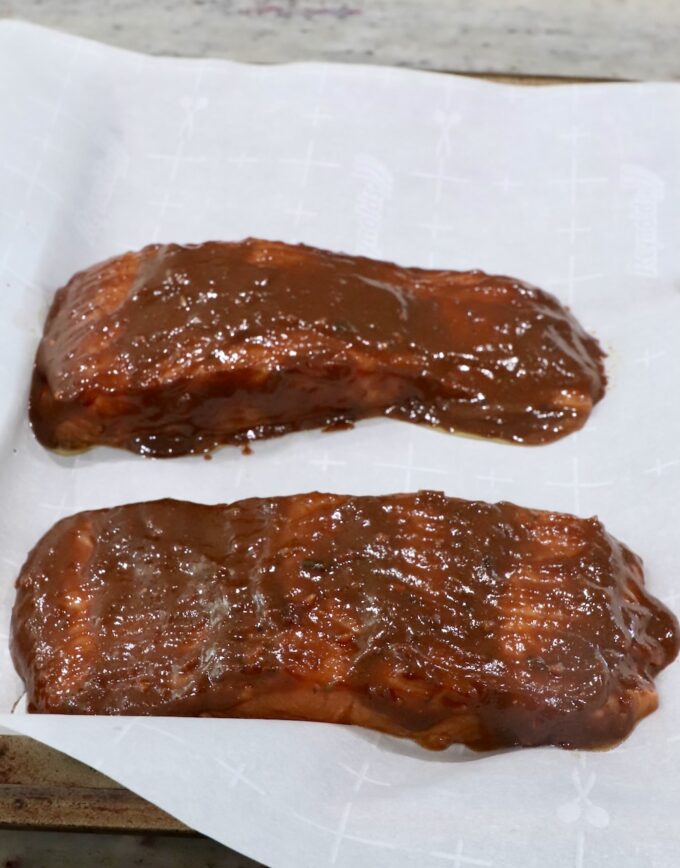
- Marinate the salmon. Add olive oil, soy sauce, balsamic vinegar, dijon mustard, honey, and Italian seasoning to a large bowl or resealable plastic bag. Add salmon fillets to the marinade and toss until the salmon is fully coated. Place the salmon in the refrigerator to marinate for at least 30 minutes, or up to 6 hours.
- Boil the marinade. After marinating the salmon, remove the filets from the marinade and place them on a sheet pan lined with parchment paper, or non-stick aluminum foil. Pour the marinade from the bag, or bowl, into a medium saucepan on the stove over high heat and bring the marinade to a boil. Once boiling reduce the heat on the stove down to medium-high heat and simmer the marinade for 5-7 minutes, or until it thickens into a glaze. Remove the glaze from the heat and let it cool for 5 minutes. It will thicken up more during this time.
- Glaze the salmon. Spread the glaze evenly over the pieces of salmon on the baking sheet.
- Cook the salmon. Place the salmon in a preheated 425°F oven for 10 minutes. Turn the oven from bake to broil on high. Cook the salmon for an additional 1-2 minutes under the broiler, or until the glaze begins to bubble and brown on top of the salmon. Always watch the salmon in the oven while it’s under the broiler to make sure it does not burn.
How to grill the salmon
You can also grill the salmon, instead of baking it in the oven. To do this, follow the instructions below.
- Marinate the salmon, boil the marinade to make a glaze, but DO NOT glaze the salmon yet.
- Preheat a grill to medium heat.
- Brush the flesh of the salmon with oil (this will prevent it from sticking to the grill) and place the salmon filets, flesh side down, directly on the hot grill grates. Cook for 3-4 minutes.
- Flip the salmon filets, so the skin side is down on the grill grates. Brush the glaze over the salmon and cook for an additional 3-4 minutes.
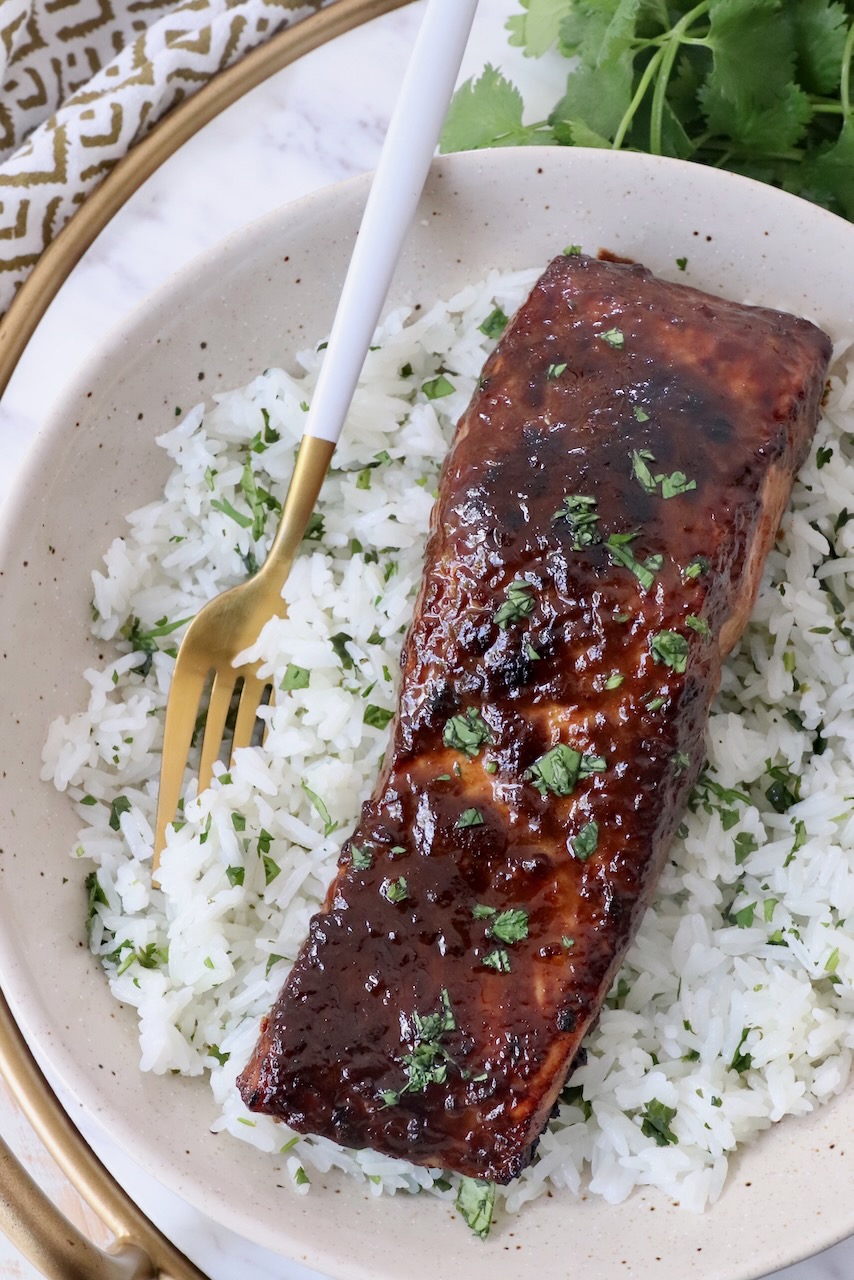
Recipe notes
- If you have a soy allergy, gluten allergy or just don’t like the taste of soy sauce, I recommend using coconut aminos instead. This soy sauce alternative is soy-free, gluten-free and contains much less sodium. For this reason, I do recommend adding 1/2 teaspoon salt to the marinade if you replace the soy sauce with coconut aminos.
- Don’t skip the step of broiling the salmon at the end in the oven. This is when the glaze will really start to caramelize over the salmon and give it the deliciously sticky texture on top.
- If your oven does not have a broiler, simply continue to bake the salmon for an additional 2-5 minutes, for a total cook time of 12-15 minutes.
- Always try to purchase salmon filets that are similar in size. If one piece of salmon is much smaller than the others, you might have to adjust the cooking time for that piece of salmon so that it doesn’t overcook. I recommend adding it to the baking sheet 2 minutes into the cooking time for the other filets.
- This recipe is made with salmon that is 1 inch thick at the thickest part of the filet. If you’re using salmon that’s much thinner, I would recommend taking 2-3 minutes off of the initial 10 minute cook time in the oven, and only cooking the salmon for 3 minutes per side on the grill. You’ll know it’s cooked when the salmon flakes easily with a fork.
- This recipe can be used to marinate up to 2 pounds of salmon.
- You do not need to remove the skin on the salmon before cooking it. And I actually don’t recommend it. The skin will keep the salmon moist as it cooks in the oven, or on the grill. The salmon’s flesh will easily peel away from the skin after you cook it. After eating the salmon, you can discard the leftover salmon skin.
- Salmon will turn from a bright orange/red color to an opaque pink as you cook it. For each inch of thickness, you should cook the salmon for 10 minutes in the oven, and 6-8 minutes on the grill. The thickest part of a center-cut salmon filet is generally about 1 inch. If your salmon is thicker or thinner, adjust the cook time accordingly.
- You should cook salmon to an internal temperature of 110°F (for rare) to 145°F (for well done). Remember that the salmon will continue to cook after you remove it from the oven or grill. I recommend removing the salmon when it reaches 5-10 degrees under your desired temperature.
What to serve with it
Salmon is delicious when you serve it with rice, veggies or salad on the side. Try pairing this marinated baked salmon with any of these tasty side dish recipes!
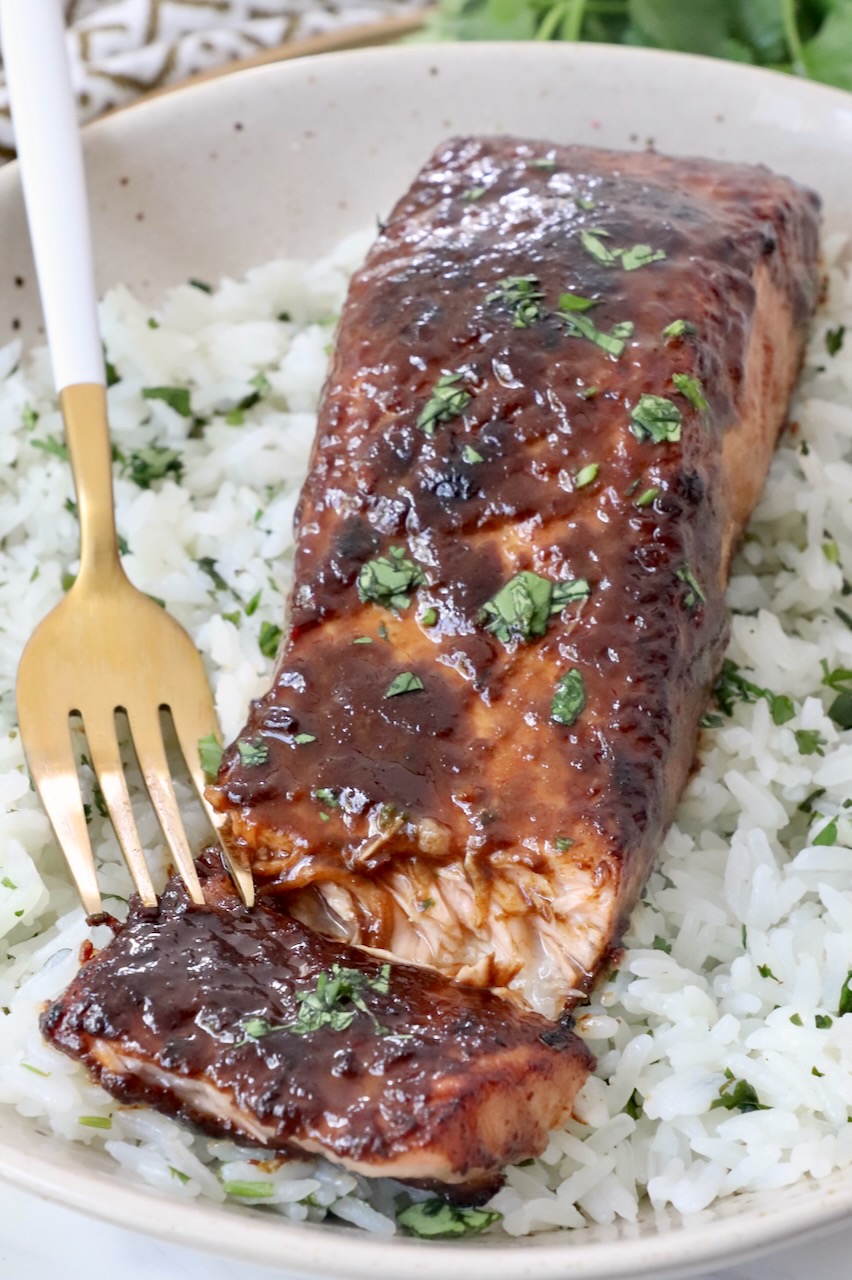
More seafood recipes
Never run out of delicious ideas for how to cook fish! Add these scrumptious seafood recipes to your weekly menu.
Salmon Marinade
Ingredients
- ¼ cup olive oil
- ¼ cup low-sodium soy sauce
- ¼ cup balsamic vinegar
- 1 tablespoon dijon mustard
- 1 tablespoon honey
- 1 teaspoon Italian seasoning, click link for recipe
- 4 salmon filets, 6-8 ounces each
Instructions
- Add the olive oil, soy sauce, balsamic vinegar, dijon mustard, honey and Italian seasoning to a large bowl or plastic bag.
- Add the salmon to the marinade and toss to coat.
- Place in the refrigerator and marinate for 30 minutes, or up to 6 hours.
- After marinating the salmon, preheat the oven to 425°F.
- Remove the filets from the marinade and place them on a baking sheet lined with parchment paper.
- Pour the marinade from the bag, or bowl, into a medium saucepan on the stove over high heat and bring the marinade to a boil.
- Once boiling reduce the heat down to medium-high and simmer the marinade for 5-7 minutes, or until it thickens into a glaze. Remove the glaze from the heat and let it cool for 5 minutes. It will thicken up more during this time.
- Spread the glaze evenly over the pieces of salmon on the baking sheet.
- Place the salmon in the oven for 10 minutes.
- Turn the oven from bake to broil on high. Cook the salmon for an additional 1-2 minutes under the broiler, or until the glaze begins to bubble and brown on top of the salmon. Always watch the salmon in the oven while it’s under the broiler to make sure it does not burn.
Notes
- To grill the salmon, instead of baking it, follow these instructions:
- Marinate the salmon, boil the marinade to make a glaze, but DO NOT glaze the salmon yet.
- Preheat a grill to medium heat.
- Brush the flesh of the salmon with oil (this will prevent it from sticking to the grill) and place the salmon filets, flesh side down, directly on the hot grill grates. Cook for 3-4 minutes.
- Flip the salmon filets, so the skin side is down on the grill grates. Brush the glaze over the salmon and cook for an additional 3-4 minutes.
- If you have a soy allergy or gluten allergy, I recommend using coconut aminos instead. This soy sauce alternative is soy-free, gluten-free and contains much less sodium. For this reason, I do recommend adding 1/2 teaspoon salt to the marinade if you replace the soy sauce with coconut aminos.
- Always try to purchase salmon filets that are similar in size. If one piece of salmon is much smaller than the others, you might have to adjust the cooking time for that piece of salmon so that it doesn’t overcook. I recommend adding it to the baking sheet 2 minutes into the cooking time for the other filets.
- This recipe is made with salmon that is 1 inch thick at the thickest part of the filet. If you’re using salmon that’s much thinner, I would recommend taking 2-3 minutes off of the initial 10 minute cook time in the oven, and only cooking the salmon for 3 minutes per side on the grill. You’ll know it’s cooked when the salmon flakes easily with a fork.
- This recipe can be used to marinate up to 2 pounds of salmon.
- You do not need to remove the skin on the salmon before cooking it. And I actually don’t recommend it. The skin will keep the salmon moist as it cooks in the oven, or on the grill.
Nutrition Facts
We are a participant in the Amazon Services LLC Associates Program, an affiliate advertising program designed to provide a means for sites to earn advertising fees by advertising and linking to amazon.com.


